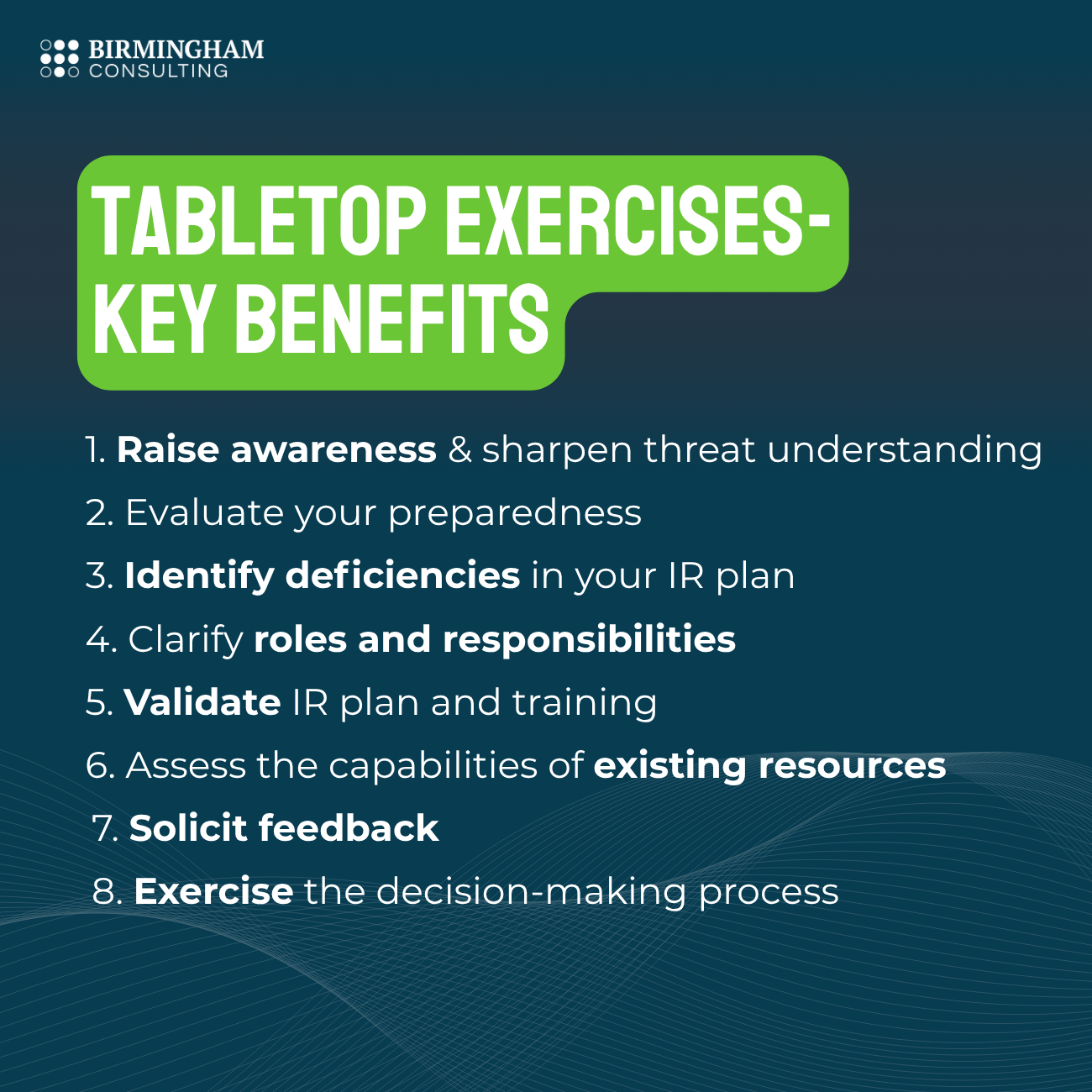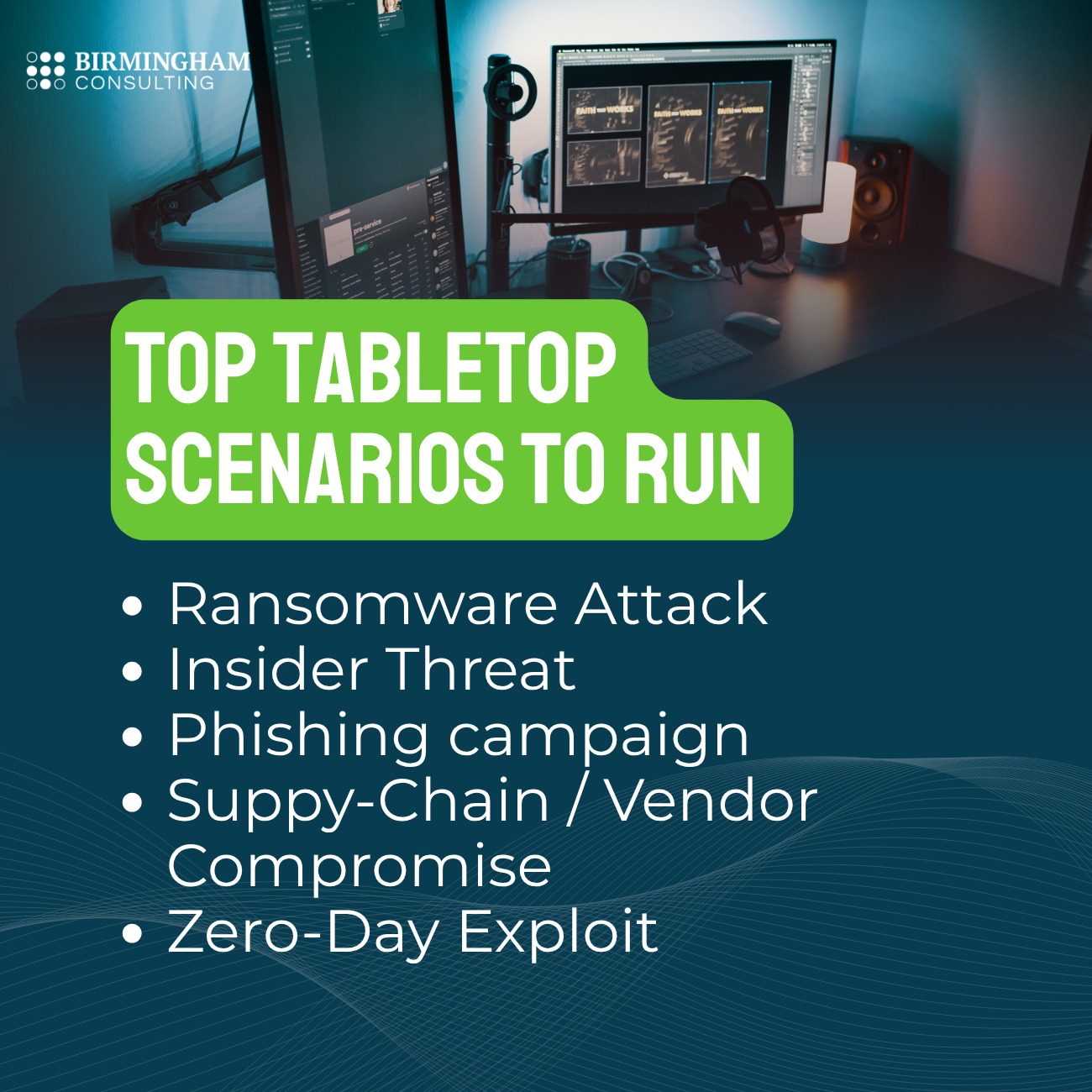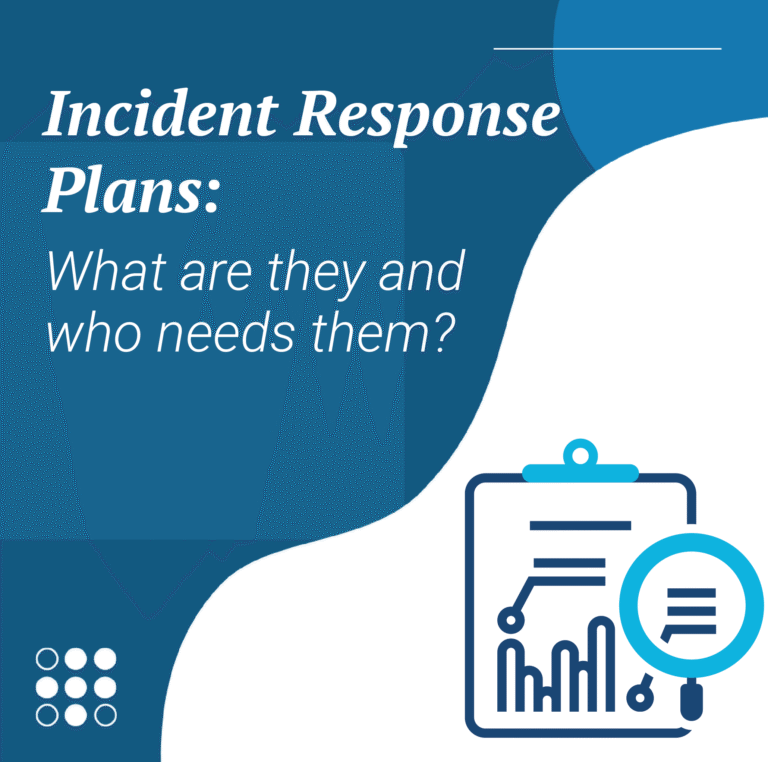Incident Response Tabletop Exercise: The “Fire Drill” of Information Security
An Incident Response Tabletop Exercise is a “Fire Drill” for a company’s Incident Response Plan (IRP) as an effective training procedure. With the complexities of AI and evolving cyber threats, organizations are needing to be more and more prepared for a variety of incidents.
Because, according to a recent StatsCan report, “The impact of cybercrime on Canadian businesses, 2023“, Canadian businesses didn’t increase their investments in information security in 2023- but they paid more in recovery costs.
A successful attack can cause not only financial loss but also significant damage to an organization’s reputation, as well. As a key part to information security strategies, mitigating these risks is best done with a well-developed Incident Response (IR) Plan. And one of the most effective ways to test and strengthen this plan is through an Incident Response Tabletop Exercise.
What is an Incident Response Tabletop Exercise?
A tabletop exercise (TTX) is a structured simulation of a cyber incident—discussion based, realistic, and scenario‑driven. Teams walk through a hypothetical breach (for example, ransomware or credential theft), discussing what they would do, who does what, and when and how actions occur. Unlike full scale drills where systems are disrupted, a tabletop keeps things low risk, but high value.
TTXs vary in complexity:
- Discussion‑based: Teams talk through the incident step by step.
- Operational: Adds hands‑on or technical elements alongside discussion.
Think of it as the team’s rehearsal before the real “big game”.
Why You Need Both an IR Plan and a Tabletop Exercise
Before diving into tabletop exercises, it’s essential to understand the importance of having a well-structured Incident Response Plan in place. The IR plan serves as the foundation for how an organization will detect, respond to, and recover from security incidents. Your IR plan is the blueprint, but if it’s never tested, it remains theoretical. Unfortunately, according to this StatsCan report, only 26% of Canadian businesses had a cyber security plan in place in 2023.
A tabletop exercise lets you:
- Test the IRP’s effectiveness in practice.
- Validate staff readiness, decision‑making & coordination under simulated pressure.
- Identify procedural gaps, outdated contacts or resource constraints.
- Clarify who does what and when… across IT, legal, communications, HR, and execs.
- Build muscle memory in a low‑risk environment.
So, for businesses to effectively respond to security incidents, it’s crucial that every member of the organization understands their roles and the specific actions they need to take. This is where the Incident Response Tabletop Exercise becomes invaluable. By simulating real-world scenarios, organizations can test their IR plan, identify weaknesses, make improvements, and ensure that all involved parties know their responsibilities.
Key Benefits of a Tabletop Exercise
Implementing a tabletop exercise can yield numerous benefits for an organization. Here are some of the key advantages:
1. Raise awareness & sharpen threat understanding
By walking through attack vectors (ransomware, phishing, supply‑chain compromise), the team grasps not just what might happen—but how and why.
Through a tabletop exercise, participants gain a deeper understanding of potential threats to the organization. These simulations bring awareness to the types of incidents that could affect business operations and the necessary steps to mitigate the risks. By discussing and analyzing various attack vectors, the team becomes more attuned to possible threats, such as spear phishing and social engineering, data breaches, or ransomware. This also aids education and training efforts, by contributing to a strong culture of security in an organization.
2. Evaluate Your Overall Incident Preparedness
Does the IRP align with your infrastructure, people and resources? A TTX exposes misalignment.
One of the primary goals of a TTX is to assess how prepared the organization is to respond to a security breach. During the exercise, participants evaluate the effectiveness of the Incident Response Plan, making sure the procedures are clear, actionable, and aligned with the company’s resources and infrastructure. This step helps pinpoint gaps in preparedness and provides opportunities to address deficiencies.
3. Identify Deficiencies in Your IR Plan
Whether outdated contact lists, missing escalation paths or mismatched tools—the exercise surfaces them.
An IR plan is a living document that should evolve as the organization’s needs and threats change. Through a tabletop exercise, you can test the plan’s effectiveness and identify areas that may need improvement. Whether it’s a procedural flaw, outdated contact information, or inadequate resources, the TTX provides insight into where the plan can be enhanced.
4. Clarify Roles and Responsibilities
During an incident, confusion kills response speed. A TTX ensures all parties know their part. It ensures that everyone involved in the response process knows exactly what is expected of them and the steps they need to take.
5. Validate IR Plan and Training
A plan looks great on paper, but does your team know it? The exercise tests both plan and people. The tabletop exercise validates whether the plan works in practice and if employees are adequately trained to handle various scenarios. It also highlights whether additional training or resources are necessary.
6. Assess the Capabilities of Existing Resources
Are detection systems working? Is communications infrastructure reliable? Do you have sufficient staffing?
A tabletop exercise allows you to assess the effectiveness of the tools, technologies, and resources available during an incident. It also gives you the chance to evaluate if your existing resources are enough to tackle a cyber attack.
7. Solicit Feedback for Continuous Improvement
Post‑exercise debriefs capture insights and actionable improvements- so your IRP evolves when your threat environment does.
Feedback from participants is crucial for continuous improvement. After the exercise, it’s important to gather insights from those involved to understand what worked, what didn’t, and what could be done better in the future. This feedback loop helps refine the incident response process and ensures that future exercises and real-world incidents are handled even more effectively.
8. Exercise the Decision-Making Process During an Incident
During a real incident, decisions must be swift. A TTX gives safe space to practice making them well. This preparation is vital for minimizing damage and recovering quickly from an incident.
The Roles and Participants in an Incident Response Tabletop Exercise
The success of an Incident Response Tabletop Exercise depends on the participation of key stakeholders across the organization. Top‑to‑bottom involvement is key.
A robust Tabletop Exercise draws from across the enterprise:
How to Plan and Execute an Incident Response Tabletop Exercise
Planning an effective tabletop exercise requires careful consideration and preparation. As such this is often a provided service by information security consultants. Below are the key steps to ensure a successful exercise:
Step 1: Define Objectives and Goals of the Incident Response Tabletop Exercise
Before starting, clearly define the goals of the tabletop exercise. Are you testing a specific part of the IR plan or evaluating the overall response process? Setting clear objectives helps guide the exercise and ensures you can measure its success.
Step 2: Develop Realistic Scenarios
Scenarios are the foundation of the tabletop exercise. Develop scenarios based on realistic threats that could affect your organization. For example, you might simulate a ransomware attack that locks critical business systems or a data breach that exposes sensitive customer information. Make sure the scenarios are relevant to your organization’s industry, size, and infrastructure.
Step 3: Engage the Right Participants
Involve the relevant stakeholders, including legal, communication, and senior leadership. These participants should be familiar with their roles during a crisis in order to act swiftly.
Step 4: Facilitate the Exercise
A facilitator is essential to guide the tabletop exercise and keep discussions on track. The facilitator will introduce the scenario, present the sequence of events, and prompt participants to discuss their actions and responses. The facilitator should ensure that each team member has an opportunity to contribute and that the exercise flows smoothly.
Step 5: Debrief and Document Findings
After the exercise, gather feedback from participants and document key insights. What went well? What could be improved? Use this information to update the Incident Response Plan and address any weaknesses uncovered during the exercise.
Top Tabletop Exercise Scenarios for Today
To keep relevance high, here are key scenarios organizations should rehearse:
- Ransomware Attack: Critical systems encrypted, ransom demanded. Tests detection, isolation, backup recovery, negotiation strategy.
- Insider Threat: Employee with access misuses data or credentials. Tests internal controls, monitoring and cross‑department response.
- Phishing Campaign / Credential Compromise: Broad campaign leads to compromised account, lateral movement. Tests email defenses, user‑training, detection.
- Supply‑Chain / Vendor Compromise: A third‑party breach cascades into your ecosystem. Tests vendor risk management, communication channels and business‑continuity.
- Zero‑Day Exploit: Unknown vulnerability exploited at scale. Tests adaptability, threat‑intelligence, rapid patching and containment.
Choose scenarios tailored to your threat profile and business context.
Incident Response Tabletop Exercise: Conclusion
In an era of rapidly evolving cyber threats, from AI‑enabled phishing to global ransomware syndicates, the difference between response and recovery often lies in practice. A well‑designed Incident Response Tabletop Exercise doesn’t just test your plan- it builds muscle memory, sharpens decision‑making and aligns your team for the moment when preparedness matters most.
Don’t wait for the alarm to ring. Hold the fire drill now- schedule your tabletop exercise, refine your IRP and ensure your organization knows what to do, when, and how.





